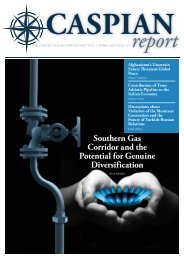You also want an ePaper? Increase the reach of your titles
YUMPU automatically turns print PDFs into web optimized ePapers that Google loves.
The pricing formula may even be<br />
more dependent on oil price fluctuations<br />
than the pricing formulae used<br />
even by Gazprom (at least until the<br />
end of <strong>2014</strong>), which are 50% linked<br />
to the price of other gas supply contracts<br />
and/or electricity prices. This<br />
does not necessarily augur well for<br />
the future of Greece’s industrial<br />
competitiveness; Greece still pays<br />
one of the highest gas prices in Europe.<br />
Despite the complications TAP created<br />
for DESFA’s privatisation, the<br />
realisation of the 10 bcm/y capacity<br />
pipeline project will also help<br />
Greece achieve another major goal of<br />
its foreign energy policy: the establishment<br />
of a South-North gas corridor<br />
that simultaneously achieves<br />
the interconnection of natural gas<br />
systems/markets from the Aegean<br />
Sea to the Danube and helps protect<br />
Central European and Balkan states<br />
from the consequences of another<br />
disruption to Russian imports that<br />
are transported through Ukraine.<br />
Since 20<strong>08</strong>, the slow pace of the development<br />
of the EU’s Southern Gas<br />
Corridor strategy led the countries of<br />
Southeast Europe to look for smaller,<br />
more affordable and more readily<br />
available diversification alternatives<br />
that combine the construction of interconnector<br />
pipelines with LNG terminals<br />
into one virtual pipeline system.<br />
This system, based on the construction<br />
of four 3-5 bcm/y capacity<br />
pipelines, would link Hungary with<br />
Greece via Bulgaria and Romania by<br />
providing all intermediary markets<br />
with non-Russian imports via the<br />
ITG and the TAP.<br />
This system of interconnecting<br />
pipelines would also allow for the<br />
rapid reverse-flow of gas in case of<br />
another major gas supply/transit<br />
crisis like the January 2009 Russian-<br />
Ukrainian crisis, which galvanized<br />
the European Commission and most<br />
of the region’s governments into action.<br />
The ongoing Russian-Ukrainian<br />
crisis, which could result in the loss<br />
of around 16% of European gas consumption<br />
attests further to the strategic<br />
importance of these interconnectors.<br />
They are crucial to the security<br />
of those member-states which<br />
are the most vulnerable to a supply<br />
shortage in the event of a Russia<br />
shutting of gas supplies.<br />
Around 50% of EU’s gas consumption<br />
is transited via the Soviet-era<br />
Ukrainian gas transmission system.<br />
This amounts to approximately 60%<br />
of Greek demand, 90% of Bulgarian<br />
demand, 20% of Romanian demand,<br />
20% of Italian demand, 52%<br />
of Austrian demand and 49.5% of<br />
Hungarian demand. 14 The 2009<br />
European Energy Programme for<br />
Recovery (EEPR) constitutes the<br />
financial underpinning of this coordinated<br />
EU effort. The EEPR covers<br />
1/3 of the total investment cost for<br />
the four abovementioned interconnectors<br />
that aspire to integrate the<br />
gas markets of Greece-Bulgaria-<br />
Romania and Hungary. 15 Since all<br />
these interconnectors are planned<br />
primarily as a means of diversifying<br />
gas imports away from Russia, they<br />
could also prove to be more beneficial<br />
to the Balkan states involved,<br />
especially those who supported the<br />
now defunct Nabucco West project<br />
like Bulgaria, Romania and Hungary.<br />
For the Eastern Balkans, the Greece-<br />
109<br />
CASPIAN REPORT, FALL <strong>2014</strong><br />
14.<br />
Authors’ estimates based on the BP Statistical Review of World Energy 2013, p.28. The estimate<br />
of a 16% loss of European, not only EU demand, of Russian gas that includes states like Turkey,<br />
Switzerland and Serbia is quoted from, U.S. Energy Information Administration (U.S. E.I.A.), Ukraine<br />
Country Note, (March 4, <strong>2014</strong>), http://www.eia.gov/countries/country-data.cfmfips=UP&trk=m<br />
15.<br />
For a detailed list of the EC funded projects under the EEPR, http://europa.eu/rapid/press<br />
ReleasesAction.doreference=IP/10/231










